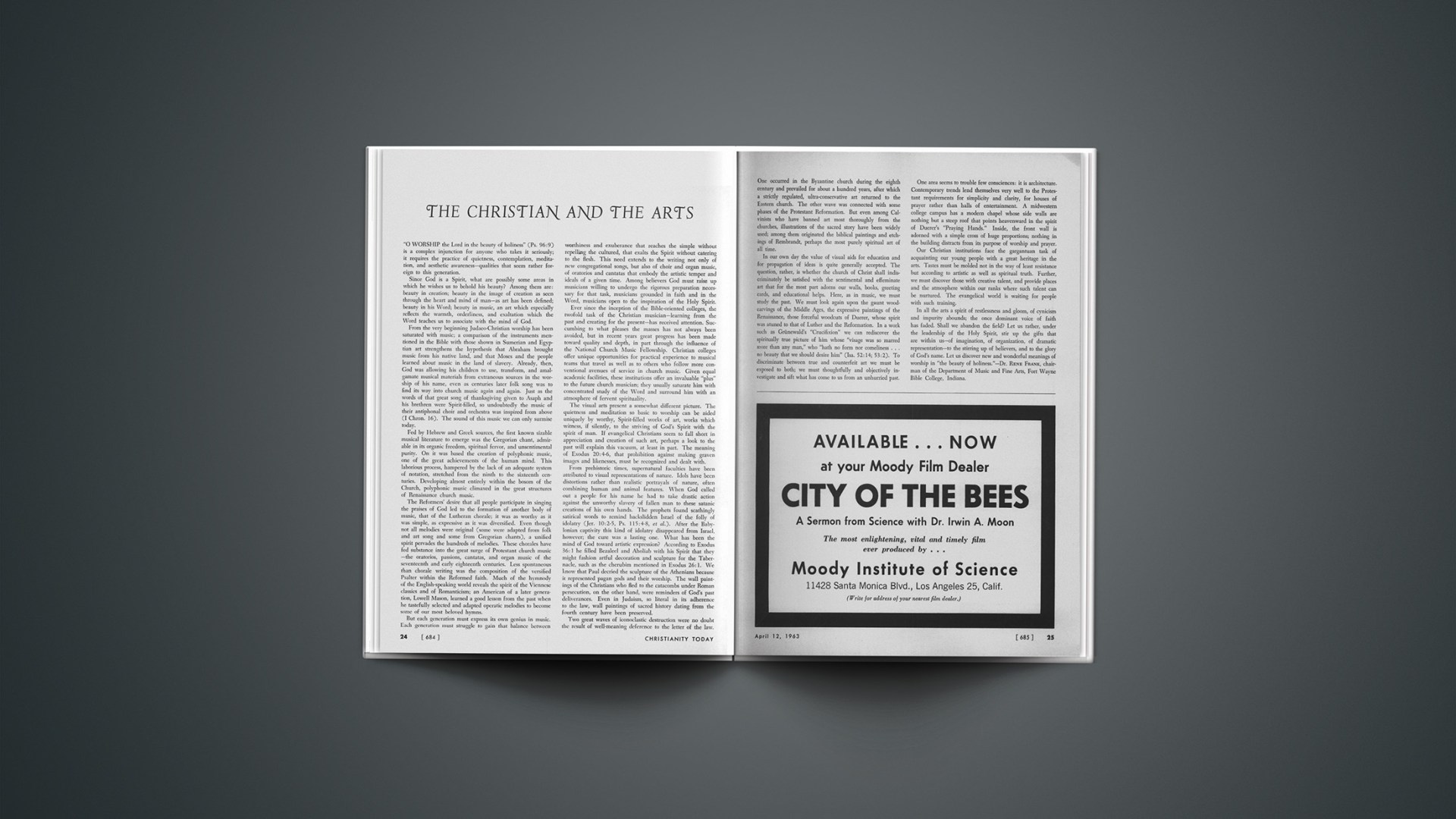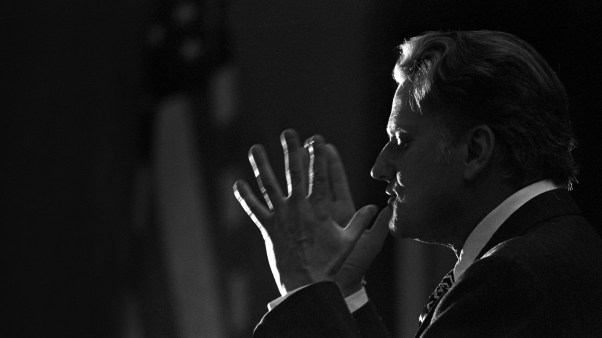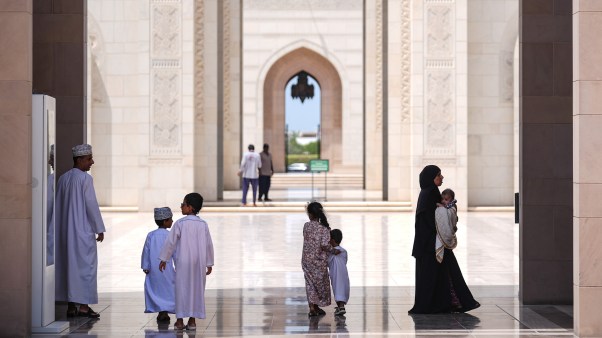“O worship the Lord in the beauty of holiness” (Ps. 96:9) is a complex injunction for anyone who takes it seriously; it requires the practice of quietness, contemplation, meditation, and aesthetic awareness—qualities that seem rather foreign to this generation.
Since God is a Spirit, what are possibly some areas in which he wishes us to behold his beauty? Among them are: beauty in creation; beauty in the image of creation as seen through the heart and mind of man—as art has been defined; beauty in his Word; beauty in music, an art which especially reflects the warmth, orderliness, and exaltation which the Word teaches us to associate with the mind of God.
From the very beginning Judaeo-Christian worship has been saturated with music; a comparison of the instruments mentioned in the Bible with those shown in Sumerian and Egyptian art strengthens the hypothesis that Abraham brought music from his native land, and that Moses and the people learned about music in the land of slavery. Already, then, God was allowing his children to use, transform, and amalgamate musical materials from extraneous sources in the worship of his name, even as centuries later folk song was to find its way into church music again and again. Just as the words of that great song of thanksgiving given to Asaph and his brethren were Spirit-filled, so undoubtedly the music of their antiphonal choir and orchestra was inspired from above (1 Chron. 16). The sound of this music we can only surmise today.
Fed by Hebrew and Greek sources, the first known sizable musical literature to emerge was the Gregorian chant, admirable in its organic freedom, spiritual fervor, and unsentimental purity. On it was based the creation of polyphonic music, one of the great achievements of the human mind. This laborious process, hampered by the lack of an adequate system of notation, stretched from the ninth to the sixteenth centuries. Developing almost entirely within the bosom of the Church, polyphonic music climaxed in the great structures of Renaissance church music.
The Reformers’ desire that all people participate in singing the praises of God led to the formation of another body of music, that of the Lutheran chorale; it was as worthy as it was simple, as expressive as it was diversified. Even though not all melodies were original (some were adapted from folk and art song and some from Gregorian chants), a unified spirit pervades the hundreds of melodies. These chorales have fed substance into the great surge of Protestant church music—the oratorios, passions, cantatas, and organ music of the seventeenth and early eighteenth centuries. Less spontaneous than chorale writing was the composition of the versified Psalter within the Reformed faith. Much of the hymnody of the English-speaking world reveals the spirit of the Viennese classics and of Romanticism; an American of a later generation, Lowell Mason, learned a good lesson from the past when he tastefully selected and adapted operatic melodies to become some of our most beloved hymns.
But each generation must express its own genius in music. Each generation must struggle to gain that balance between worthiness and exuberance that reaches the simple without repelling the cultured, that exalts the Spirit without catering to the flesh. This need extends to the writing not only of new congregational songs, but also of choir and organ music, of oratorios and cantatas that embody the artistic temper and ideals of a given time. Among believers God must raise up musicians willing to undergo the rigorous preparation necessary for that task, musicians grounded in faith and in the Word, musicians open to the inspiration of the Holy Spirit.
Ever since the inception of the Bible-oriented colleges, the twofold task of the Christian musician—learning from the past and creating for the present—has received attention. Succumbing to what pleases the masses has not always been avoided, but in recent years great progress has been made toward quality and depth, in part through the influence of the National Church Music Fellowship. Christian colleges offer unique opportunities for practical experience to musical teams that travel as well as to others who follow more conventional avenues of service in church music. Given equal academic facilities, these institutions offer an invaluable “plus” to the future church musician; they usually saturate him with concentrated study of the Word and surround him with an atmosphere of fervent spirituality.
The visual arts present a somewhat different picture. The quietness and meditation so basic to worship can be aided uniquely by worthy, Spirit-filled works of art, works which witness, if silently, to the striving of God’s Spirit with the spirit of man. If evangelical Christians seem to fall short in appreciation and creation of such art, perhaps a look to the past will explain this vacuum, at least in part. The meaning of Exodus 20:4–6, that prohibition against making graven images and likenesses, must be recognized and dealt with.
From prehistoric times, supernatural faculties have been attributed to visual representations of nature. Idols have been distortions rather than realistic portrayals of nature, often combining human and animal features. When God called out a people for his name he had to take drastic action against the unworthy slavery of fallen man to these satanic creations of his own hands. The prophets found scathingly satirical words to remind backslidden Israel of the folly of idolatry (Jer. 10:2–5; Ps. 115:4–8, et al.). After the Babylonian captivity this kind of idolatry disappeared from Israel, however; the cure was a lasting one. What has been the mind of God toward artistic expression? According to Exodus 36:1 he filled Bezaleel and Aholiab with his Spirit that they might fashion artful decoration and sculpture for the Tabernacle, such as the cherubim mentioned in Exodus 26:1. We know that Paul decried the sculpture of the Athenians because it represented pagan gods and their worship. The wall paintings of the Christians who fled to the catacombs under Roman persecution, on the other hand, were reminders of God’s past deliverances. Even in Judaism, so literal in its adherence to the law, wall paintings of sacred history dating from the fourth century have been preserved.
Two great waves of iconoclastic destruction were no doubt the result of well-meaning deference to the letter of the law. One occurred in the Byzantine church during the eighth century and prevailed for about a hundred years, after which a strictly regulated, ultra-conservative art returned to the Eastern church. The other wave was connected with some phases of the Protestant Reformation. But even among Calvinists who have banned art most thoroughly from the churches, illustrations of the sacred story have been widely used; among them originated the biblical paintings and etchings of Rembrandt, perhaps the most purely spiritual art of all time.
In our own day the value of visual aids for education and for propagation of ideas is quite generally accepted. The question, rather, is whether the church of Christ shall indiscriminately be satisfied with the sentimental and effeminate art that for the most part adorns our walls, books, greeting cards, and educational helps. Here, as in music, we must study the past. We must look again upon the gaunt wood-carvings of the Middle Ages, the expressive paintings of the Renaissance, those forceful woodcuts of Duerer, whose spirit was atuned to that of Luther and the Reformation. In a work such as Grünewald’s “Crucifixion” we can rediscover the spiritually true picture of him whose “visage was so marred more than any man,” who “hath no form nor comeliness … no beauty that we should desire him” (Isa. 52:14; 53:2). To discriminate between true and counterfeit art we must be exposed to both; we must thoughtfully and objectively investigate and sift what has come to us from an unhurried past.
One area seems to trouble few consciences: it is architecture. Contemporary trends lend themselves very well to the Protestant requirements for simplicity and clarity, for houses of prayer rather than halls of entertainment. A midwestern college campus has a modern chapel whose side walls are nothing but a steep roof that points heavenward in the spirit of Duerer’s “Praying Hands.” Inside, the front wall is adorned with a simple cross of huge proportions; nothing in the building distracts from its purpose of worship and prayer.
Our Christian institutions face the gargantuan task of acquainting our young people with a great heritage in the arts. Tastes must be molded not in the way of least resistance but according to artistic as well as spiritual truth. Further, we must discover those with creative talent, and provide places and the atmosphere within our ranks where such talent can be nurtured. The evangelical world is waiting for people with such training.
In all the arts a spirit of restlessness and gloom, of cynicism and impurity abounds; the once dominant voice of faith has faded. Shall we abandon the field? Let us rather, under the leadership of the Holy Spirit, stir up the gifts that are within us—of imagination, of organization, of dramatic representation—to the stirring up of believers, and to the glory of God’s name. Let us discover new and wonderful meanings of worship in “the beauty of holiness.”—Dr. RENE FRANK, chairman of the Department of Music and Fine Arts, Fort Wayne Bible College, Indiana.










